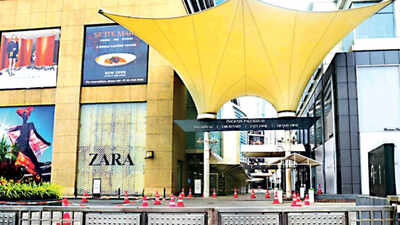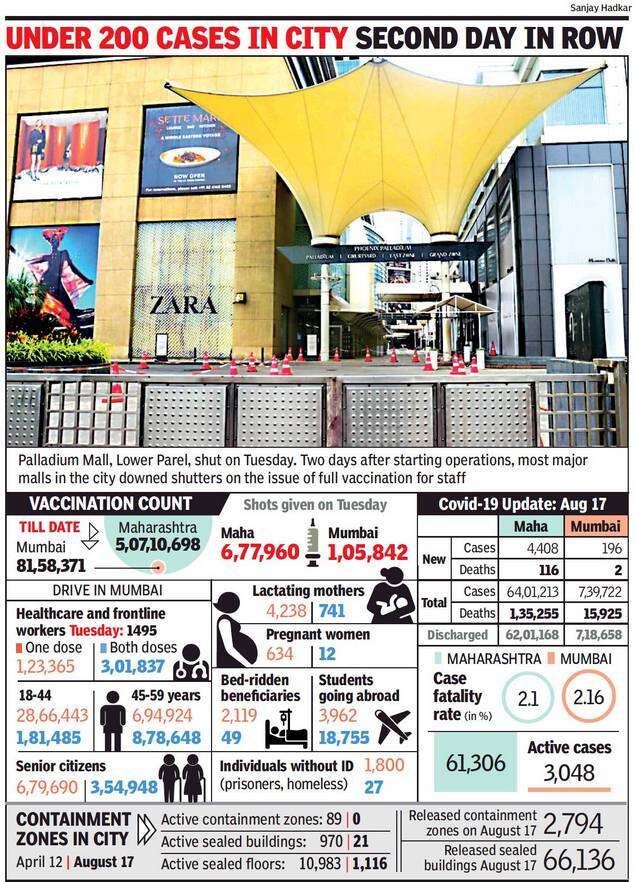Top Searches
- News
- City News
- mumbai News
- End of second wave? Number of sealed buildings in Mumbai falls 98% since April
End of second wave? Number of sealed buildings in Mumbai falls 98% since April

Palladium Mall, Lower Parel, shut on Tuesday. Two days after starting operations, most major malls in the city downed shutters on the issue of full vaccination for staff
MUMBAI: In yet another sign that the second Covid wave in Mumbai has abated, the number of sealed buildings has dropped by almost 98% in the last four months. Only 21 buildings are sealed across the city at the moment, a huge drop from 970 on April 12.
“Mumbai is at its lowest ebb of the pandemic right now,” said Dr Shashank Joshi, a member of the state task force on Covid. The daily tally across the city has been less than 300 for about a week now and the daily toll too has dropped below 10.

The BMC seals a building if five or more residents test positive for Covid-19. In case there are fewer than five cases in a building, the floor where the patient lives is cordoned off. The number of sealed floors touched 10,983 in the second week of April, but has now dropped to 1,116.
On Saturday, for the first time since the pandemic began in March 2020, the city had no containment zones --- slum pockets or congested areas that are cordoned off due to numerous cases. During the peak of the second wave in April, the city had close to 2,800 containment zones. The BMC would barricade the congested areas to restrict vehicular movement in and out of these areas.
BMC additional commissioner Suresh Kakani got the city’s present Covid trend analysed and found new cases were mainly emerging from buildings and there were no clusters of cases in any part of the city.
Joshi, however, advocated caution. “We have just begun unlocking and if people don’t follow Covid-appropriate behaviour and get themselves vaccinated, we could be looking at another disaster,” he added.
Abhishek Ghosalkar, former Shiv Sena corporator from Dahisar, said the second wave had barely touched slums pockets. For example, Dahisar’s Ganpat Patil Nagar, one of the largest slum pockets with a population of upwards of 60,000, reported very few cases unlike in the first wave when it was a hotspot. The BMC sealed the slum in May when cases rose to 12. “BMC officials adopted an aggressive strategy of screening locals that resulted in even asymptomatic people getting diagnosed. This helped control the spread of infection in the Dahisar cluster,” said Ghosalkar.
In Goregaon, BJP corporator Srikala Pillai, whose ward has slums such as Bhagat Singh Nagar 1 & 2, Laxmi Nagar and Indira Nagar, said the first wave was harsh on slumdwellers, who had to step out to keep home fires burning.
Nehal Shah, a BJP corporator from Matunga-Sion, said slum-dwellers had developed herd immunity by the time the second wave hit. “There are concerns of the third wave probably hitting us again, but the government can avoid this by ensuring that those in the slums at least take one dose of the vaccine,” said Shah.
“Mumbai is at its lowest ebb of the pandemic right now,” said Dr Shashank Joshi, a member of the state task force on Covid. The daily tally across the city has been less than 300 for about a week now and the daily toll too has dropped below 10.

The BMC seals a building if five or more residents test positive for Covid-19. In case there are fewer than five cases in a building, the floor where the patient lives is cordoned off. The number of sealed floors touched 10,983 in the second week of April, but has now dropped to 1,116.
On Saturday, for the first time since the pandemic began in March 2020, the city had no containment zones --- slum pockets or congested areas that are cordoned off due to numerous cases. During the peak of the second wave in April, the city had close to 2,800 containment zones. The BMC would barricade the congested areas to restrict vehicular movement in and out of these areas.
BMC additional commissioner Suresh Kakani got the city’s present Covid trend analysed and found new cases were mainly emerging from buildings and there were no clusters of cases in any part of the city.
Joshi, however, advocated caution. “We have just begun unlocking and if people don’t follow Covid-appropriate behaviour and get themselves vaccinated, we could be looking at another disaster,” he added.
Abhishek Ghosalkar, former Shiv Sena corporator from Dahisar, said the second wave had barely touched slums pockets. For example, Dahisar’s Ganpat Patil Nagar, one of the largest slum pockets with a population of upwards of 60,000, reported very few cases unlike in the first wave when it was a hotspot. The BMC sealed the slum in May when cases rose to 12. “BMC officials adopted an aggressive strategy of screening locals that resulted in even asymptomatic people getting diagnosed. This helped control the spread of infection in the Dahisar cluster,” said Ghosalkar.
In Goregaon, BJP corporator Srikala Pillai, whose ward has slums such as Bhagat Singh Nagar 1 & 2, Laxmi Nagar and Indira Nagar, said the first wave was harsh on slumdwellers, who had to step out to keep home fires burning.
Nehal Shah, a BJP corporator from Matunga-Sion, said slum-dwellers had developed herd immunity by the time the second wave hit. “There are concerns of the third wave probably hitting us again, but the government can avoid this by ensuring that those in the slums at least take one dose of the vaccine,” said Shah.
FacebookTwitterLinkedinEMail
Start a Conversation
end of article

